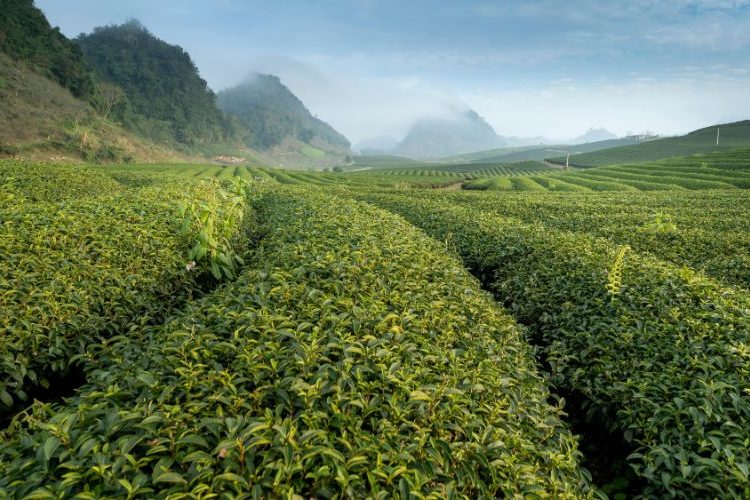With more than 145,000 tons of production capacity and more than 170 tea varieties, Vietnam tea is now an increasingly appealing option for companies looking for a stable, varied, and budget-friendly source.
The following article is an overview of the main tea-producing regions in Vietnam, typical types of products, and related import prices. It will help you better plan your sourcing and optimize your business plan.
Inside Vietnam’s Tea Industry
With increasing numbers of individuals globally becoming interested in the Vietnamese tea benefits, Vietnam is now the fifth-largest tea-exporting and producing country globally, placed after China, India, Kenya, and Sri Lanka. The country exported around 145,000 tons of tea in 2024 worth approximately USD 256 million. That is over 25% volume and 27% value more than in 2023.
Black tea accounts for about 80% of total exports, followed by green tea and oolong. Further, some Vietnamese producers are starting to focus more on value-added items like herbal teas and naturally scented teas (e.g., lotus or jasmine) rather than raw leaf exports alone.
Vietnam tea is exported to over 70 nations. The largest market is Pakistan, representing more than 35% of value and volume of exports in 2024. According to an interview, Mr. Nguyen Quoc Manh, the Deputy Director of the Department of Crop Production, stated that Vietnam’s export of tea could reach 156,000 tons by 2030 with a constant annual growth rate of about 0.83%.
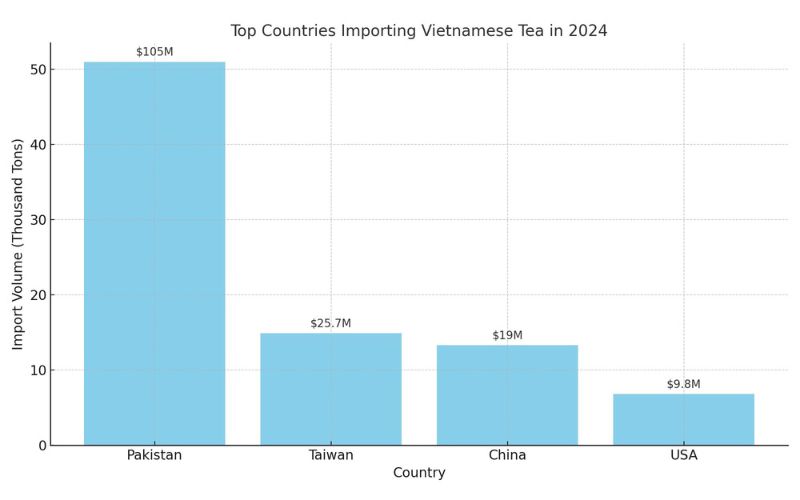
Key Regions for Tea Sourcing in Vietnam
1. Thai Nguyen Province
Thai Nguyen is the tea capital of Vietnam with over 22,200 hectares of tea estates and yielding over 250,000 tons of fresh tea leaves every year. It produces traditional green tea with the special young rice aroma, with slight bitterness and long lasting sweetness.
However, most of the tea that is grown in Thai Nguyen is still farmed by small farmers, and this makes it difficult to maintain consistent quality from organic farming to final processing. This can affect total product stability batch by batch.
2. Lam Dong Province
Lam Dong produces over 164,100 tons of tea annually, and the high-grade oolong tea is its leading product, especially from Bao Loc and Cau Dat. Lam Dong tea is typically yellow in color, mild in bitterness, and sweet and clean in aftertaste, and therefore is appropriate for mid- and high-level markets.
In addition, LD97 type tea, with thick fine hairs on buds and fresh leaves, is mainly used for pu-erh, tea bag, and milk tea manufacturing. Raw material LD97 tea is around USD 15/kg. However, raw materials in Lam Dong are overall 20–30% higher in price compared to the north, and buyers seeking competitive prices need to consider this factor.
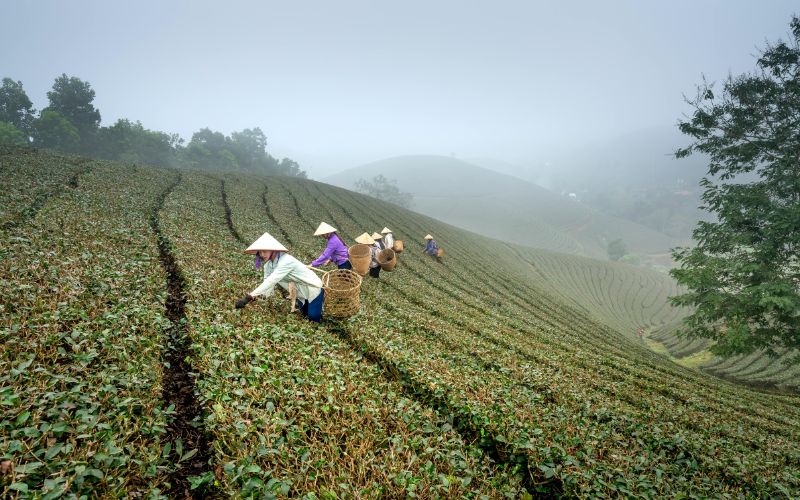
3. Phu Tho Province
Phu Tho province is located in northern Vietnam and boasts over 14,000 hectares of tea cultivation that produces around 178,900 tons of fresh tea leaves annually. Black tea accounts for around 70% of its processed output. This tea is moderately astringent, typical of fermented teas, but has a smooth feel, leaving a light, lingering sweetness on the palate.
Phu Tho tea is shipped to the Middle East, India, and UK for its compliance with global standards such as GlobalGAP and Rainforest Alliance. However, the production of high-grade green tea here has not yet been well-developed—something importers should consider as regards premium green tea supplies.
4. Northwestern Provinces (Son La, Yen Bai, Ha Giang, Lao Cai, and Lai Chau)
Son La and Lai Chau are the largest tea-producing provinces in this area and of these, Son La grows as much as 5,850 hectares of tea. The Northwest region produces predominantly the Shan Snow (Shan Tuyet) type of tea, which covers over 80% of the total area of production. Shan Snow tea is renowned for large buds and pale fragrance, having the scent of forest flowers, herbs, or young rice. The brewed colour is normally bright and light yellow.
While the region is ideal for tea cultivation (e.g., good drainage, mild climate, and frequent fog), logistics are not easy with the mountainous landscape. This could be an issue for customers who value an efficient supply chain.
7 Common Vietnamese Tea Types and Products
- Black tea: Commonly used in tea bags, milk tea, and the food industry. It goes through full oxidation, giving it a strong flavor and a color that ranges from light brown to deep red.
- Green tea: A daily drink for many. It has a moderate caffeine level—between Chinese and Japanese green tea. Thai Nguyen green tea is especially well-known for its fresh aroma, light bitterness, and long-lasting sweet aftertaste.
- Shan Snow (San Tuyết) tea: A premium, hand-picked tea from old tea trees in Vietnam’s northwest mountains. The buds are covered in fine white hairs and have a smooth, herbal aroma. Often packaged as boutique or high-end gift products.
- Oolong tea: A semi-fermented tea made through a complex process, including withering, rolling, partial oxidation, and shaping. Its flavor can range from fruity to nutty or floral. It is popular in the premium gift market.
- Lotus tea: Made by infusing green tea with lotus flowers for about a day. This popular tea in Vietnam has a sweet, enchanting floral aroma.
- Jasmine tea: A blend of green tea and jasmine flowers. It has a strong scent and a light, pleasant aftertaste. Often served as a refreshing drink, it’s in high demand in restaurants, hotels, and beverage chains.
- Herbal tea: Includes teas made from ginger, artichoke, lemongrass, and more. Positioned in the wellness segment, it’s known for helping with relaxation, digestion, and detox. Popular in markets that value organic and healthy products.
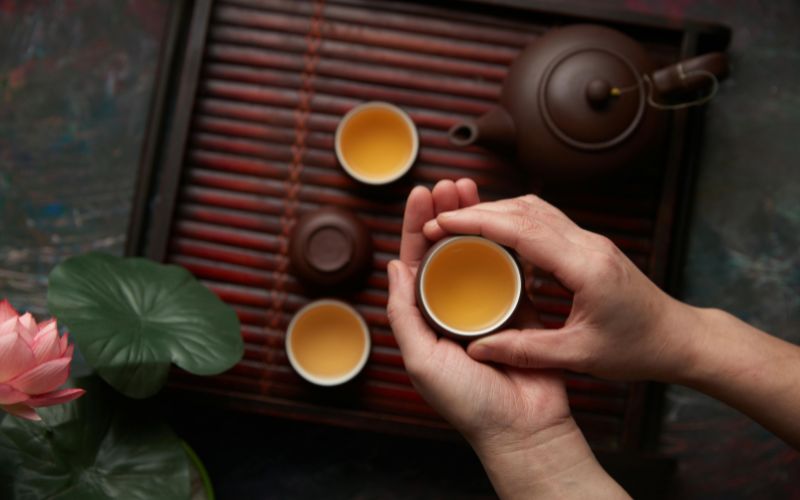
Top 3 Vietnam Tea Sourcing Companies
Below are some of the largest tea production and export companies in Vietnam:
1. Vinatea
Founded in the 1950s, Vinatea currently owns about 4,300 hectares of tea-growing land and operates processing factories in northern provinces such as Phu Tho, Moc Chau, Thai Nguyen, and Yen Bai.
Their product range includes traditional green tea, herbal tea, and premium teas like ancient Shan Snow. Vinatea is certified by international standards such as Rainforest Alliance and follows the Sustainable Agriculture Network guidelines. Today, Vinatea exports to over 120 partners in demanding markets like the U.S., Taiwan, and Sweden.
2. Hatvala
Hatvala sources its tea directly from eco-friendly and wild tea farms in Ha Giang, Lao Cai, Son La, and Yen Bai. Its product range includes Shan Tuyet tea processed in different styles: green, white, oolong, black, and fermented pu-erh. The company also offers seasonal scented teas such as jasmine, chrysanthemum, and lotus.
Hatvala’s teas are now enjoyed in over 40 countries. Some Hatvala tea reviews have praised the clean, smooth flavor of their teas—especially the traditional green tea.
3. AsiaTea
AsiaTea has an annual production capacity of around 20,000 tons, exporting to more than 45 countries, including China, Thailand, Singapore, and several European nations. The company sources raw materials from over 1,200 tea gardens in Phu Tho, with most of them certified by Rainforest Alliance.
Their main products include Orthodox black tea and CTC black tea, classified by international grading standards. The Orthodox line includes OPA, PEKOE, OP, BOP, FBOP, PS, BPS, F, and DUST grades and can be customized to meet buyer requirements. The CTC line includes grades like CTC BOP, BP, PD, and PF, also tailored for bulk orders by market.
Vietnam Tea Sourcing Costs and MOQs
The average export price of Vietnamese tea is around $1.7 per kilogram, which is only about 65% of the global average price ($2.6/kg). Below is a reference table with FOB prices and minimum order quantities (MOQs) for some common types of tea in Vietnam:
| # | Type of Vietnam Tea | Estimated FOB Price (USD/kg) | Typical MOQ |
| 1 | Green Tea (from Moc Chau) | $1.7 | 100 kg |
| 2 | Green Tea (from Thai Nguyen) | $5 – $15 | 100-1,000 kg |
| 3 | Black Tea | $1.85 | 1.000 – 10.000 kg |
| 4 | Oolong Tea (premium, made from Shan Snow tea) | $15 – $30 | 1.000 kg or more |
| 5 | Oolong Tea (good quality, sourced from Lam Dong) | $8 – $15 | 1.000 kg or more |
| 6 | Oolong Tea (standard grade) | $4 – $8 | 1.000 kg or more |
| 7 | Shan Snow Tea | $10 – $20 | 5 – 25 kg (for loose tea leaf); 6.000 – 10.000 kg (for dry tea) |
| 8 | Lotus-Scented Tea | $3 – $5 | 2.200 kg or more |
| 9 | Jasmine Tea (loose tea) | $1 – $3 | 0.1 – 100 kg |
| 10 | Jasmine Tea (high-quality or organic) | $10 – $30 | 500 kg or more |
Key Considerations When Sourcing Made-in-Vietnam Tea
Before placing any order with a Vietnamese tea supplier, it’s crucial to evaluate three core aspects to ensure product compliance, quality control, and cost efficiency:
1. Check required certifications and requirements for your nation
Appropriate documents are required to import tea from Vietnam in order to adhere to your country’s safety and customs guidelines. The documents not only guarantee the tea is healthy and safe to be consumed but also prevent delays, rejection, or additional inspections during border crossing. Recommended documents are:
- Phytosanitary Certificate: Required for the importation of raw or loose tea as proof of pest-free product.
- Organic certifications such as USDA Organic, EU Organic, or Rainforest Alliance. These certifications are important if you’re targeting high-standard markets like the EU, the US, or Japan.
- Certificate of Origin (C/O): Needed to benefit from tariff reductions under trade agreements.
- Food safety certifications such as HACCP or ISO 22000 are often required by retailers, factories, or large F&B chains.
- Other specific certifications (if required). Some include Halal for Islamic markets or Fair Trade for socially conscious markets.
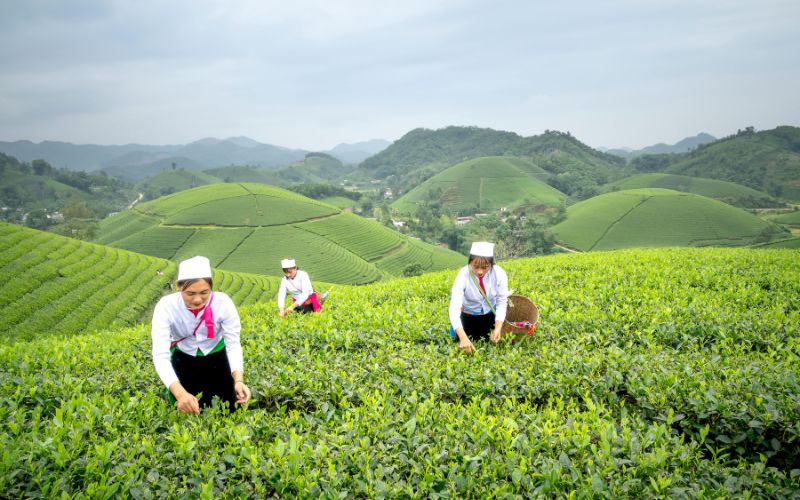
2. Check sample products and keep uniform quality
Before purchasing in bulk, you need to request samples from Vietnamese tea brands to check for aroma, taste, brew color, leaf length, and purity. In the case of flavored or processed teas like lotus, jasmine, or oolong, you need to ensure that the natural flavorings are permissible and as per food regulations in your country. For instance, EU Regulation No. 1334/2008 allows only natural flavorings in products labeled as “naturally flavored tea.”
3. Define the pricing system and undisclosed charges:
Be sure to ask what is included in the price—such as raw tea, basic processing (sorting, rolling, drying), packaging, certifications, and inspection fees. Also, be cautious of additional charges like special packaging, third-party testing (e.g., SGS, Intertek), label printing, or handling fees for small or LCL (Less than Container Load) orders.
VinaSources: All-in-One B2B Sourcing Platform for Vietnam Tea
If you are seeking trustworthy suppliers or even wondering where to find Vietnam tea sourcing suppliers, VinaSources can make the process convenient and hassle-free. As a single-stop B2B sourcing platform, VinaSources directly links global buyers with pre-verified Vietnamese tea suppliers.
Below is how VinaSources is an efficient, transparent, and cost-effective way to source tea from Vietnam:
- Direct access to reliable brands: The entire suppliers of tea on the platform are pre-screened for export licenses, production capability, and required certifications mentioned above. This ensures importers interact only with approved partners who meet international quality and safety standards.
- Basic quote requests: Send an RFQ with your target volume, target price, tea grade and type, packaging requirements, and other requirements.
- Complete supply chain support: VinaSources manages everything for you, including logistics, documents, and supplier follow-up.
Contact us today and start your tea-sourcing journey from Vietnam now!
